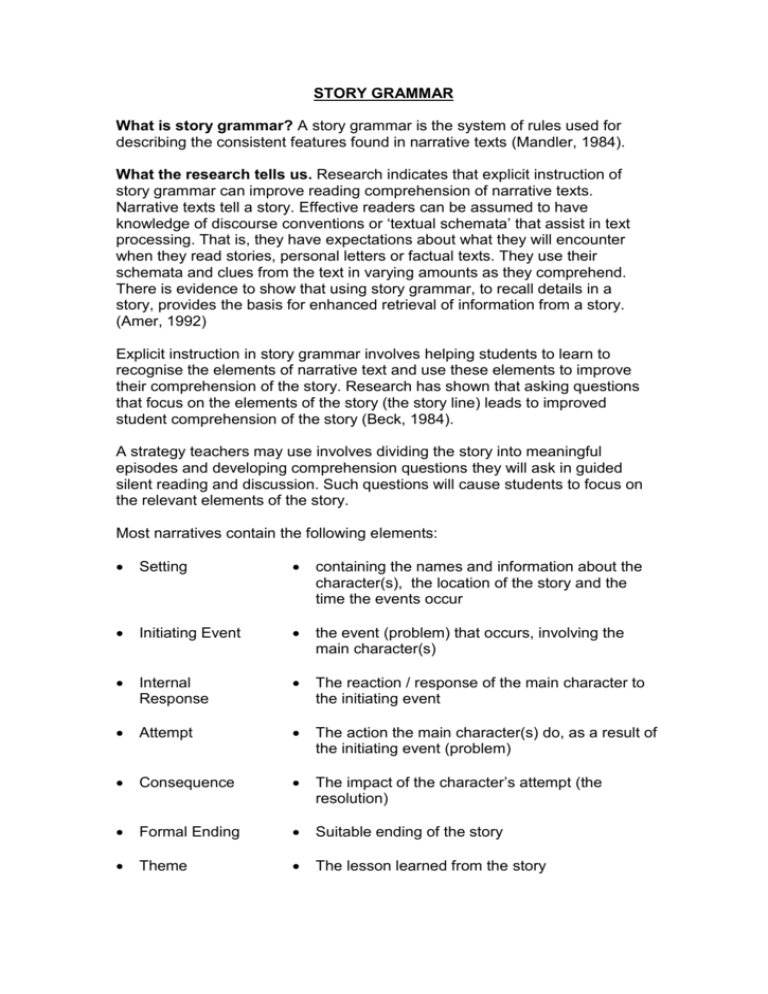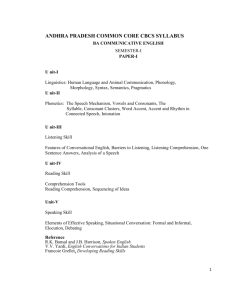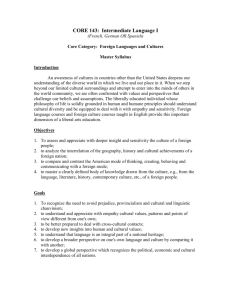What is story grammar?
advertisement

STORY GRAMMAR What is story grammar? A story grammar is the system of rules used for describing the consistent features found in narrative texts (Mandler, 1984). What the research tells us. Research indicates that explicit instruction of story grammar can improve reading comprehension of narrative texts. Narrative texts tell a story. Effective readers can be assumed to have knowledge of discourse conventions or ‘textual schemata’ that assist in text processing. That is, they have expectations about what they will encounter when they read stories, personal letters or factual texts. They use their schemata and clues from the text in varying amounts as they comprehend. There is evidence to show that using story grammar, to recall details in a story, provides the basis for enhanced retrieval of information from a story. (Amer, 1992) Explicit instruction in story grammar involves helping students to learn to recognise the elements of narrative text and use these elements to improve their comprehension of the story. Research has shown that asking questions that focus on the elements of the story (the story line) leads to improved student comprehension of the story (Beck, 1984). A strategy teachers may use involves dividing the story into meaningful episodes and developing comprehension questions they will ask in guided silent reading and discussion. Such questions will cause students to focus on the relevant elements of the story. Most narratives contain the following elements: Setting containing the names and information about the character(s), the location of the story and the time the events occur Initiating Event the event (problem) that occurs, involving the main character(s) Internal Response The reaction / response of the main character to the initiating event Attempt The action the main character(s) do, as a result of the initiating event (problem) Consequence The impact of the character’s attempt (the resolution) Formal Ending Suitable ending of the story Theme The lesson learned from the story TEACHING STORY GRAMMAR (reading) Teachers ask students to read a passage (silently). For younger students, teacher might read the story to the students. The students are then asked to answer the guiding questions (based on story grammar) to draw their attention to the structure of the episode (story). The questions may be adapted to serve the content of each episode in the story. Guiding questions: Setting: Where did the story happen? When did the story happen? Characters: Who was the story about? Who were the people in the story? Who was the most important person in the story? Initiating What event (problem) occurred involving the main character(s)? Event: Action: What was the reaction (internal response) of the main character? What did the characters do, in response? (attempt) What was the impact of the character’s attempt, the resolution? (consequence) How did the characters solve the problem? (action) Ending: How did the story end? Theme: What lesson could we learn from the story? Writing a Narrative using story grammar (Ref: Write Ways – Lesley Wing Tan) A set of questions (based on story grammar) that can be used by the teacher, or by the students themselves, to help them to plan their writing of narratives. Plot What is going to happen? What will happen first / next / last? Why will that happen? What words will you use to describe the action? Setting Where will the story take place? What will the setting be like? Have you got a picture of the setting in your mind? When will the story take place? (past, present, future) What words will you use to describe the setting? Characterisation Who / what are the main characters? What do they look like? What words would you use to describe each one’s appearance? How would you describe the nature of each character? Structure How are you going to begin your story? What will be your lead sentence? What is the problem (main initiating event) in your story? How is this situation going to be resolved? How will you end your story? What lesson could we learn from your story? What is a possible title for the story? Other useful strategies for helping students to plan their writing of narratives Prepare a story map (pictorial representation) to plot the actions and settings of each event in the story. Write a character profile for each of the main characters in the story. Tell your planned story to a partner to help them to clarify their ideas. * Most narratives are written either in the first or third person. References Amer, A.A. (1992) The Effect of Story Grammar Instruction on EFL Students’ Comprehension of Narrative Text. Reading in a Foreign Language 8 (2), p. 711 - 720. Beck, I.L. (1984) Developing comprehension: The impact of the direct reading lesson. In R.C. Anderson, J. Osborn and R. Tierney (Eds.) Learning to read in American schools. Hillsdale, N.J: Lawrence Associates. Mandler, J.M. (1984) Stories, scripts and scenes: Aspects of schema theory. Hillsdale, N.J: Erlbaum. Wing Jan, L. (1987) Write Ways : Modelling writing forms.







